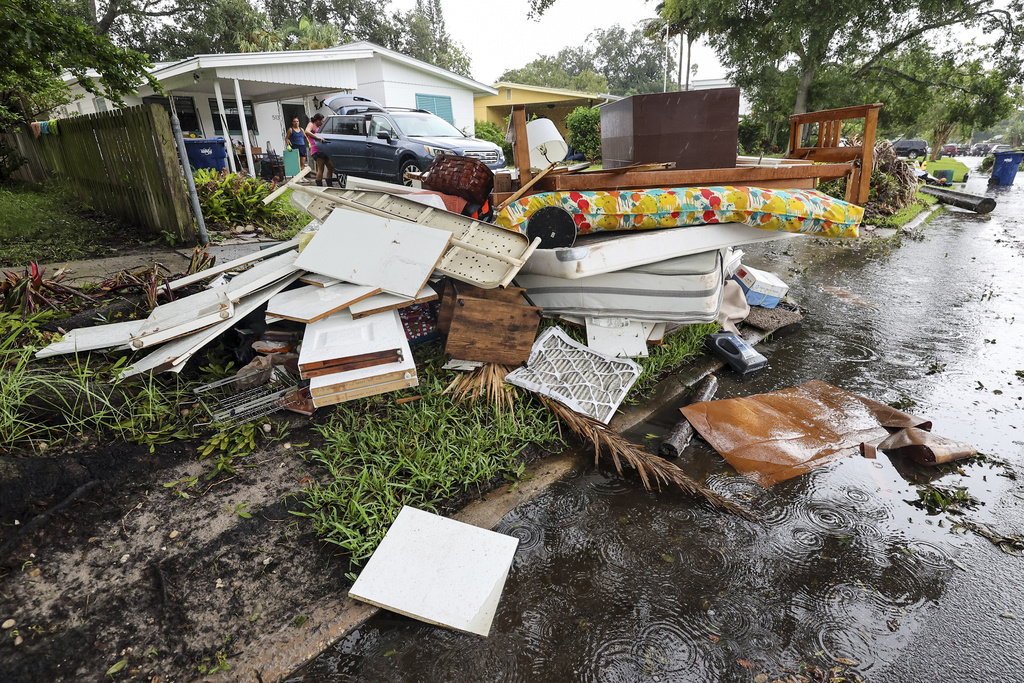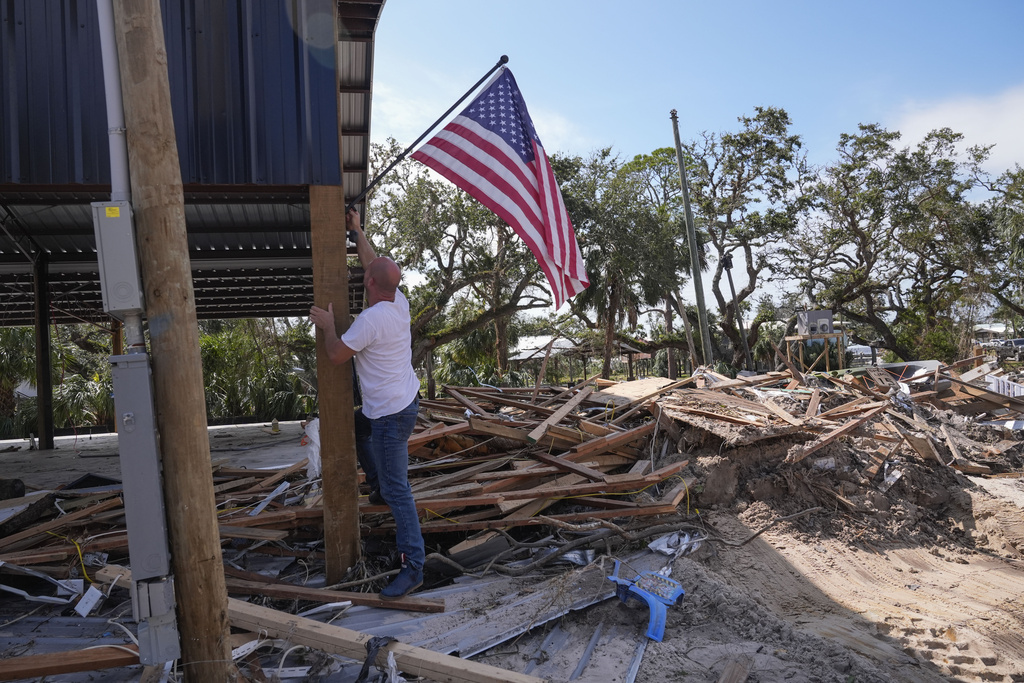Helene Causes Widespread Flooding and Power Outages \ Newslooks \ Washington DC \ Mary Sidiqi \ Evening Edition \ Hurricane Helene has left widespread destruction across the Southeastern U.S., with 56 confirmed deaths and millions still without power. The storm, which came ashore as a Category 4 hurricane, has caused severe flooding, closed major roads, and prompted emergency rescues across several states. President Biden pledged federal support for recovery efforts, while local communities struggle to restore basic services.

Helene Causing Flooding: Quick Looks
- Death Toll Rising: At least 56 deaths have been confirmed across five states, with the toll expected to increase as officials assess further.
- Major Flooding and Power Outages: Millions across the Southeast remain without power, with extensive flooding in parts of North Carolina, Georgia, and Tennessee.
- Emergency Helicopter Rescues: Dozens of residents, including hospital patients in Tennessee, have been airlifted due to severe flooding.
- Devastation in Tennessee and Florida: Tennessee Governor Bill Lee described the damage as “heartbreaking.” Florida’s Big Bend area has been hit by three hurricanes in just over a year.
- Community Support in Crisis: Grovetown, Georgia, hosted a community cookout to prevent food from spoiling, while Perry, Florida, residents lined up for aid as nearly all were still without power.
- Communication Breakdowns: In Buncombe County, North Carolina, communication outages have delayed official announcements of fatalities as families await news.
- President Biden’s Commitment: Biden assured residents that federal assistance would continue, approving emergency declarations for multiple states to support the recovery.
- Vice President Harris’s Warning: Harris urged those impacted to follow local guidelines amid ongoing risks of flooding and additional damages.
Helene’s Aftermath: Deep Look
Hurricane Helene unleashed massive destruction across the Southeastern United States, leaving a devastating toll in its wake. As of Saturday, the storm’s remnants had dissipated, but millions were still without power, and parts of southern Appalachia continued to face historic river flooding. With at least 56 fatalities confirmed across five states, the full extent of the damage was still being assessed by authorities and emergency workers.
Death Toll and Widespread Devastation
Helene made landfall as a Category 4 hurricane late Thursday, bringing winds of 140 mph to Florida’s Gulf Coast. The storm’s ferocity continued as it moved rapidly through Georgia, the Carolinas, and Tennessee, uprooting trees, destroying homes, and flooding rivers and creeks. The confirmed death toll includes 23 people in South Carolina and 11 in Florida. However, officials anticipate that the number of casualties will likely rise as communication is restored and more thorough assessments are made.
In Buncombe County, North Carolina, the damage has been particularly severe, with Asheville bearing the brunt of the storm. Local authorities have stated that while they are aware of fatalities, communication challenges have hindered their ability to notify next of kin, delaying official announcements. This has added to the frustration and anxiety of families seeking information about their loved ones.
Flooding and Community Struggles
Flooding has been one of the most pervasive issues following Helene’s path, with roads across western North Carolina becoming impassable due to landslides and high waters. Authorities in Rutherford County have resorted to airlifting residents trapped in areas like Lake Lure and Chimney Rock Village, emphasizing the severity of the situation. In the town of Asheville, flooding submerged entire sections, cutting off communication lines and leaving residents stranded. Francine Cavanaugh, whose sister was in Asheville, described the sense of helplessness as she struggled to get in touch with her family members amid widespread cell service outages.
Dramatic Rescues Amid the Chaos
Perhaps one of the most striking rescue stories came from Unicoi County, Tennessee, where dozens of patients and medical staff had to be rescued by helicopter from a hospital rooftop. Floodwaters from the Nolichucky River inundated the hospital, and officials scrambled to evacuate 54 individuals safely. A Virginia State Police helicopter, along with other National Guard aircraft, managed to carry out the rescue mission over several hours amid challenging conditions.
Meanwhile, in Florida, the impact of Helene has left entire communities struggling to rebuild. Ten of the 11 confirmed deaths in Florida occurred in the Tampa Bay area, largely as a result of drowning in homes located within mandatory evacuation zones. The neighborhood of Davis Islands, home to prominent athletes like Derek Jeter and Tom Brady, experienced chest-high storm surges that severely damaged homes and businesses. Though residents were warned to evacuate, many chose to stay, expecting a less severe outcome. Faith Pilafas, who watched the waters rise to over four feet from her second-story apartment, said she and others had underestimated the storm’s power.
Local Support and Community Initiatives
As communities cope with the aftermath, local initiatives have emerged to support those in need. In Grovetown, Georgia, a town near Augusta, officials organized a community cookout to prevent thawing meat from going to waste after widespread power outages. The initiative aimed to feed both residents and the crews working tirelessly to restore power. With over 99% of Columbia County still without electricity on Saturday, the simple act of providing a hot meal became a beacon of hope for many residents.
Similarly, in Perry, Florida, residents lined up for food distribution as power remained out for almost the entire county. Sierra Land, who arrived early at the Convoy of Hope distribution site with her children and grandmother, described the situation as a daily struggle to make ends meet. She spoke of her grandfather, Franklin Ratliff, who has dementia and COPD, and how the lack of power for his oxygen machine had made the situation even more dire.
President Biden and Federal Response
President Joe Biden expressed deep sorrow over the destruction caused by Hurricane Helene and vowed to support recovery efforts. Speaking from Rehoboth Beach, Delaware, Biden called the devastation “overwhelming” and reiterated that federal aid would continue to flow to the affected states, which include Florida, Georgia, Alabama, South Carolina, North Carolina, and Tennessee. He approved federal emergency declarations for all these states, authorizing FEMA to provide assistance to save lives, protect property, and support overall emergency response measures. Biden emphasized that the federal government would stay the course and not abandon the affected communities during their long road to recovery.
Vice President Kamala Harris also urged those affected by the storm to heed local officials’ guidance, highlighting the continuing danger from flooding and other storm-related hazards. Her call to action came as she visited Douglas, Arizona, emphasizing the need for people to prioritize safety while authorities worked to bring relief.
Long Recovery Ahead for the Southeast
The road to recovery is expected to be lengthy for the Southeastern U.S. as officials assess the extent of the damage and begin rebuilding efforts. In eastern Georgia, Governor Brian Kemp noted that the damage was comparable to a bomb going off, with the devastation stretching from Valdosta to Augusta. He acknowledged the significant efforts required to restore power and infrastructure across the region.
Georgia Power Company reported that over 525,000 customers were still without electricity, while electric cooperatives in the area struggled with severe damage to transmission lines and substations. In total, more than 800,000 customers across Georgia remained without power, and officials estimated it could take days to assess and repair the damage fully.
Florida’s Big Bend Faces Repeated Disasters
Florida’s Big Bend area, particularly Taylor County, has been battered by three major hurricanes in just over a year. John Berg, a resident of Steinhatchee, described the relentless nature of the storms and the reality they brought to the community. Businesses that had barely recovered from Hurricane Idalia were once again left in ruins. A beloved local landmark, Roy’s restaurant, which had stood for decades, was reduced to debris by Helene’s powerful surge. Berg noted that rebuilding would require substantial changes, including raising structures higher to withstand future storms.
Hope Amidst the Ruins
Despite the devastation, resilience shone through in the efforts of local communities and emergency responders. The stories of neighbors helping one another, like those using kayaks to assist stranded residents on Tampa’s Davis Islands, highlighted the enduring spirit of those affected. While the path to recovery may be long and fraught with challenges, the collective efforts of local officials, federal agencies, and ordinary citizens provided a glimmer of hope for the region’s future.
From dramatic helicopter rescues to community cookouts and federal pledges of support, the aftermath of Hurricane Helene has shown both the destructive power of nature and the unbreakable human spirit in the face of adversity. The recovery will be complex, requiring extensive resources and coordination, but for now, the people of the Southeast are taking it one day at a time, driven by resilience and the hope of rebuilding their lives.
Helene Causes Widespread Helene Causes Widespread Helene Causes Widespread Helene Causes Widespread







